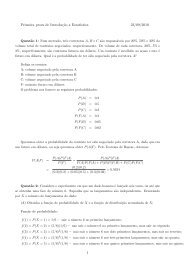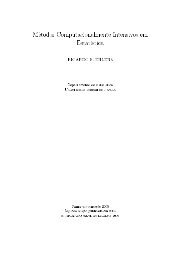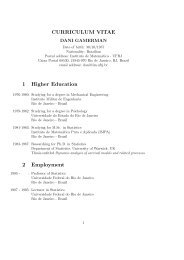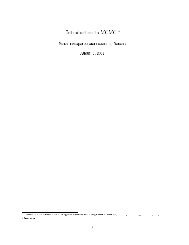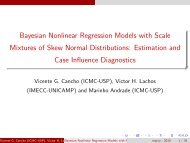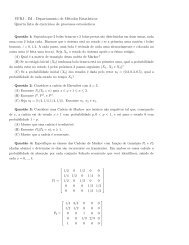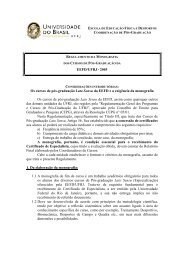Copulas: a Review and Recent Developments (2007)
Copulas: a Review and Recent Developments (2007)
Copulas: a Review and Recent Developments (2007)
Create successful ePaper yourself
Turn your PDF publications into a flip-book with our unique Google optimized e-Paper software.
usually wish to aggregate two-dimensional framework to obtain a multidimensionalone. Even though the construction of families of joint distribution functions forgiven univariate marginals has been so widely studied, the case of higher dimensionalmarginals has been focused more on study of compatibility of overlapping marginals<strong>and</strong> bounds for the corresponding Frechet classes, see Joe (1997), Chapter 3.In dimension n = 3, consider the class H(H X1 X 2;H X1 X 3)with¯xedorknownbivariate marginals H X1 X 2<strong>and</strong> H X1 X 3, assuming that the ¯rst univariate marginal F X1is the same. This class is always non-empty since it contains trivariate distributionswhich are such that the second <strong>and</strong> the third variables X 2 <strong>and</strong> X 3 are conditionallyindependent given the ¯rst one X 1 , i.e. always is possible to ¯nd the joint distributionH(x 1 ;x 2 ;x 3 )=Z x1¡1H X2 jX 1(x 2 jx)H X3 jX 1(x 3 jx)dF X1 (x):Moreover, observe that in such a case the usual Frechet boundsmaxfF X1 (x 1 )+F X2 (x 2 )+F X3 (x 3 ) ¡ 2; 0g <strong>and</strong> minfF X1 (x 1 );F X2 (x 2 );F X3 (x 3 )gcan be improved, see Joe (1997). The last relation can be extended to the n-variatedistribution, given two di®erent (n ¡ 1)-dimensional margins, containing (n ¡ 2) variablesin common.If we consider the class H(H X1 X 2;H X1 X 3;H X2 X 3) with ¯xed or known bivariatemarginals H X1 X 2, H X2 X 3<strong>and</strong> H X2 X 3, then compatibility conditions for bivariatemarginals are obtained by considering two of the three margins to be arbitrary, <strong>and</strong>the third bivariate margin to have constraints given the other two. The uniqueness<strong>and</strong> compatibility conditions are discussed by Joe (1997), see also Dall'Aglio (1972)for some necessary conditions.Therefore, one cannot just select a parametric family of functions with the rightboundary properties <strong>and</strong> expect them to satisfy the rectangle condition (1) of a multivariatejoint distribution function. Generally, a family of multivariate distributionsmust be constructed through methods such as mixtures, stochastic representations<strong>and</strong> limits, see Joe (1997), Chapter 4.In fact, the usual copula theory is devoted to the class of n-variate distributionsH(F X1 ;::: ;F Xn ), in which the univariate margins F X1 ;::: ;F Xn are given, see (2).The insu±ciency of the copula function to h<strong>and</strong>le distributions with given multivariatemarginals is illustrated by the Nutshell copula's paradox discussed by Genestet al. (1995). They showed that the only possibility thatH(x 1 ;::: ;x n1 ;x n1 +1;::: ;x n1 +n 2)=C(H n1 (x 1 ;::: ;x n1 );H n2 (x n1 +1;::: ;x n1 +n 2))de¯nes a (n 1 + n 2 )-dimensional distribution function, n 1 + n 2 ¸ 3, for all H n1 <strong>and</strong>H n2 (with dimensions n 1 <strong>and</strong> n 2 , respectively) is the independence copula.Schweizer <strong>and</strong> Sklar (1981) o®ered the following serial iterative approach for constructingcopulas: Consider some bivariate copula C, setC 2 (u 1 ;u 2 )=C(u 1 ;u 2 )<strong>and</strong>iterateC k (u 1 ;::: ;u k¡1 ;u k )=C(C k¡1 (u 1 ;::: ;u k¡1 );u k ); k ¸ 3;23




